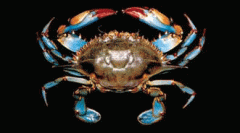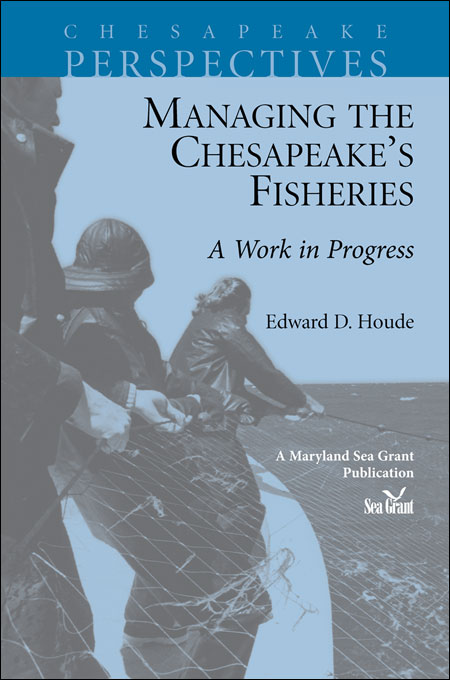Knauss legislative fellowships in Congress help build careers — and they're fun and educational. See our video and fact sheet for details.
A Challenge in Climate Change Research: Facing the Skeptics
Climate change is an accepted phenomenon throughout the scientific community, but the perspective of the general public can often be quite different. As a young researcher in the field of climate change, I often find myself in situations where climate change skeptics expect me to defend my research.
My Ph.D. dissertation work is about the effects of climate change, in particular the warming and acidification of coastal waters, on juvenile blue crabs in the Chesapeake Bay. I am based at the University of Maryland Center for Environmental Science Chesapeake Biological Laboratory (CBL) in Solomons, Maryland, located at the mouth of the Patuxent River.
A substantial portion of my research was designing a large flow-through system – a system of glass aquaria of different sizes that allowed me to manipulate water temperature and pH to very specific levels. My flow-through system moved hundreds of gallons of water per minute through the tanks, making it one of the largest aquaria systems ever built at CBL. During the summer of 2015, I kept close to 100 tiny blue crabs alive to test the effects of warming temperatures and declining pH levels on crab growth. This required me to make many trips to various hardware stores, marine supply depots, and everywhere in between in order to obtain supplies for my construction project.
My preparation for and construction of the system required me to frequently interact with various members of the general public: employees at the local Ace hardware; my distributor friends (see above); and citizens of southern Maryland who came to outreach events and toured CBL’s facilities. Frequently I would arrive at the hardware store with a bag of plumbing or electrical fittings that I needed to somehow connect together, using any means necessary, as long as those means cost less than $10. The time I spent in person or on the phone with various community members allowed me to communicate my research goals to the people whom my research is supposed to help – the greater Chesapeake Bay community.
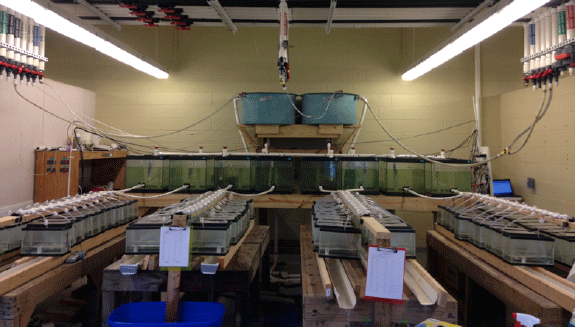 |
|
I used this experimental system at Chesapeake Biological Laboratory to study the simulated effects of climate change on juvenile crabs. Temperature was manipulated in the large tanks in the rear. pH was controlled in the smaller tanks on the long tables. Each small tank contained an individual, tiny blue crab (25mm in width) for about one month. Credit: Hillary Glandon |
Few people told me flat out that they thought my work was pointless – but I encountered many folks who understood the reality of climate change but did not understand how ordinary citizens could influence its course. “What is the point in spending tax dollars to research something that we can’t do anything about?” a hardware store clerk might say. Or a waterman might comment, “I’m catching way fewer crabs these days. Can’t you do something about that instead of worrying about ocean warming?”
My first thoughts when I hear these comments are usually something like, “I didn’t come to your job and question the validity of what you do. Can’t you just leave me to find my washers and be on my way?” But then I realize that this situation is a great opportunity to engage a community member about the importance of understanding climate change and doing scientific research in general. I try to point out that while climate change is a global challenge, as citizens of the Chesapeake Bay region, we can have a big impact on the functioning of our local ecosystem. Planting rain gardens, getting involved with a local riverkeeper’s group, or buying food that uses less fertilizers, which reduces pollution into the Bay, are all ways that everyday folks can influence the dynamics of our local estuary. If my skeptics are accompanied by children or mention their kids/grandkids, I try to go that route, empowering them to learn more about the environment that they live in for the sake of the next generation.
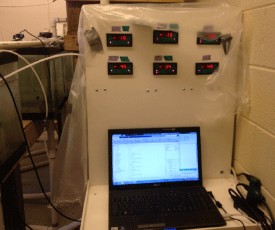 |
| A control system recorded pH in the small tanks once per second. Photo credit Hillary Glandon |
In response to my watermen friends, I use a similar strategy meant to pique their curiosity and challenge their assumptions. I liken myself to them: I am (becoming) an expert on climate change and how it may impact blue crabs in the Chesapeake Bay, just as they are experts in fishing in their region. I am doing my best to make decisions about my research based upon my existing knowledge base, just as they make decisions about their fishing based on their knowledge and experience. I don’t claim to know all of the answers, but I’m doing my best with what I’ve got!
I try to end each interaction with a plug for them to come visit me at the lab (if they live near Solomons) or give them information about a marine science lab near where they are located. People are often afraid of what they don’t understand, and just getting folks in the lab door and exposed to what we are doing as scientists is a great way to start to change some people’s minds. On more than one occasion I’ve had my head in a crab tank (literally) when I received a visit from someone with whom I had talked the weekend before at a CBL outreach event such as the local blue crab festival.
I have found that once people take the time to come to the lab, they are often pleasantly surprised with what I am trying to do, which is to understand the ins and outs of an important species in the region. It becomes clear to them that we are all working towards the same larger goal, to live and thrive in the greater Chesapeake Bay ecosystem; we may just approach it in different ways. Some of us conduct experiments, others wake up at dawn to gather the bounty from the Bay, and still others help to shape the regulations that will help to maintain a healthy Chesapeake Bay for all. My strategy doesn’t work every time, but even if it works half the time, the more people on the side of science, the better!
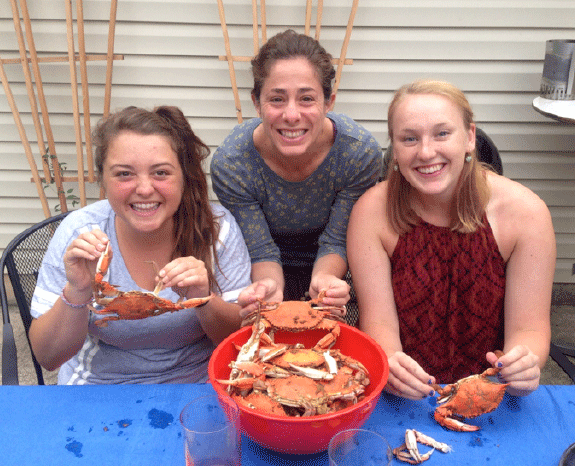 |
|
The Summer 2015 CBL Blue Crab Team: I am shown here between two college students who I mentored, Annie Nyffeler (left) and Maddie Schwaab (right). These crabs were not from our experiment; it would have taken a couple of years for our little guys to reach that size. But a definite perk of blue crab research is having connections with watermen who are willing to share the Bay’s bounty! Yum! Credit: Hillary Glandon |
Photo, top left: The adult blue crab: Callinectes sapidus Credit: Hillary Glandon
See all posts to the Fellowship Experiences blog
